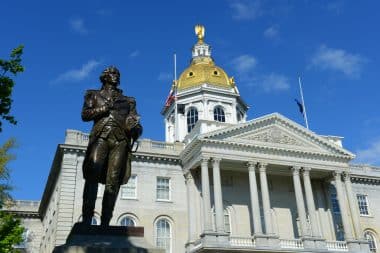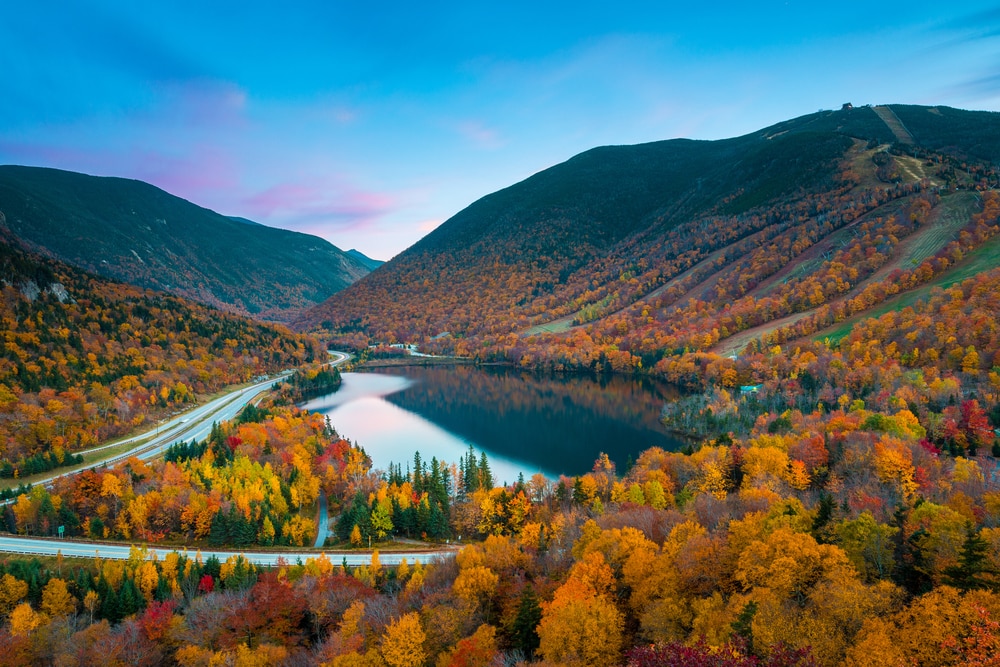A US contrast to sunny California and Florida awaits in New Hampshire, where the colourful autumn nature of the so-called Indian Summer in a scenery of mountains, lakes and covered bridges provides unique photo motifs. As a neighboring state of Maine and Vermont, New Hampshire spreads the typical charm of New England’s Atlantic coast. The Granite State is more than just the scenic link on Interstate 95 between Boston and Portland: from the colorful autumn worlds of the White Mountains to the picturesque Lakes Region and the white winter sports worlds of Mount Washington, a unique natural paradise unfolds here. A region that has unmistakably inspired local poets and authors such as Robert Frost, Dan Brown and John Irving.
New Hampshire’s Nature – Colorful Autumn Scenery and White Winter Sports Worlds

New Hampshire is an outdoor paradise on the Atlantic coast. The tranquil shore of the eastern US state unfolds over a length of about 29 kilometres – the shortest coastline of the US states located on the ocean. But even along these only 29 kilometers, some of the most beautiful places on the US East Coast unfold. These include Hampton Beach, which is especially worth visiting in summer, as well as beautiful beach worlds at Rye and North Hampton State Beach. Inland, however, are the real natural highlights of New Hampshire. Deep in the interior of the state, natural elevations present themselves that have always attracted the interest of nature lovers, hikers and winter sports enthusiasts. One of the most climbed mountains in the world is Mount Monadnock, which rises 965 meters in the southwest of New Hampshire. South of the White Mountains rises the mountain that once inspired Ralph Waldo Emerson and Henry David Thoreau – and is now climbed by more than 100,000 nature lovers and hikers every year. Only well-known surveys such as Mount Fuji in Japan and the Tai Shan in China can surpass such figures.
All the allure of New Hampshire’s nature unfolds in the White Mountains, whose landscapes spread out in the White Mountain National Forest. The highest peak is the 1917-meter-high Mount Washington, which is known for its distinctive ski resorts in winter. The natural beauty of red, yellow and green in the so-called Indian Summer, the warm autumn time of the North American East Coast, unfolds visually, especially in the White Mountain National Forest, through which routes such as the scenic Kancamagus Highway lead. New Hampshire is particularly impressive at this time of year with a natural panorama including the typical covered bridges that characterize New England – whether the Albany Bridge, the Bath Covered Bridge or the Groveton Covered Bridge. Many of these bridges are located in the White Mountains, some in the Lakes Region – they provide the characteristic romantic flair of New Hampshire.
Home to a population of about 1.3 million, the Granite State owes its nickname to its many quarries, as well as the distinct rock and mineral shapes that are hidden in the midst of New Hampshire’s natural formations. In addition to the Appalachian Mountains and the White Mountains, the lakes of the Lakes Region also shape the local nature. One of the most famous is Lake Winnipesaukee, the largest of the local lakescapes. In addition, Squam Lake and Newfound Lake also make New Hampshire’s nature a multifaceted recreational region on the US East Coast.
Concord, Manchester, Portsmouth – Urban New Hampshire

New Hampshire’s historic colonial architecture gives an indication of the long history of the US state: The eastern coastal region was once one of the historic English colonies, founded in 1629 as the Province of New Hampshire. Later, it was considered the first U.S. state to present an independent government and constitution. Although New Hampshire has a much larger city in Manchester and a prominent capital in Concord, a deep historical insight can be gained especially in Portsmouth. The city on the border with Maine, located on Interstate 95 between Portland and Boston, has the historic Strawberry Banke, an open-air museum with early colonial settlements from the 17th century. The museum is one of the most famous in New Hampshire. In addition, Portsmouth offers touristically attractive urban destinations in New Hampshire’s north with its historic buildings in the city center, the historic Market Square and the tranquil Prescott Park.
The fact that New Hampshire has deep British roots is proven not only by Portsmouth but also by the name of the largest city Manchester. With the Currier Museum of Art, the city has perhaps the most important art museum in New Hampshire. The permanent collection includes works by Picasso, Monet and Matisse, as well as American art greats John Singer Sargent, Georgia O’Keeffe and Frank Lloyd Wright. Historical flair also unfolds in the centrally located capital Concord, home to about 43,000 inhabitants. Here you can discover sights such as the historic New Hampshire State House or the historic Eagle Hotel: US President Ulysses S. Grant, the famous First Lady Eleanor Roosevelt and the aviation pioneer Charles Lindbergh once stayed in the latter. Parks like Story Land near Glen and Santa’s Village near Jefferson prove that New Hampshire also has highlights for the family. In this way, New Hampshire forms a fascinating contrast to classic US travel destinations such as California or Florida. Especially when the warm autumn shows its colors in natural New Hampshire.


